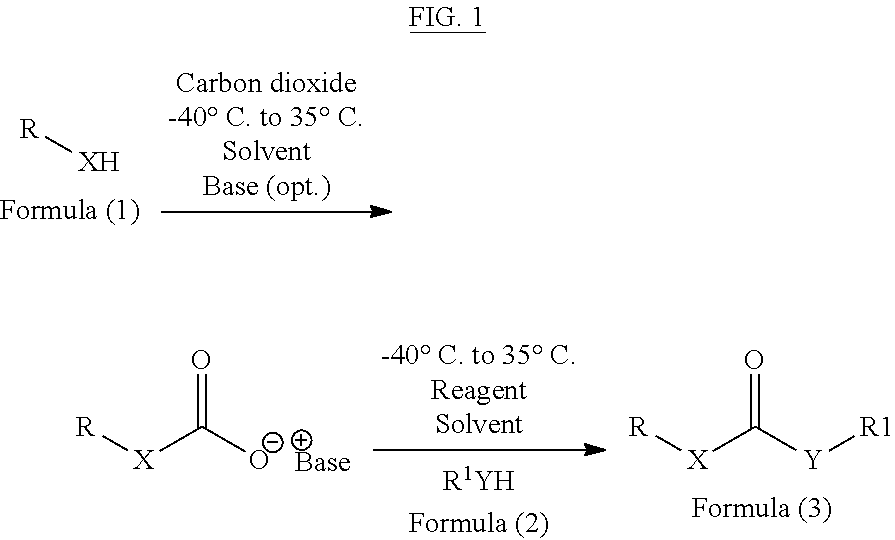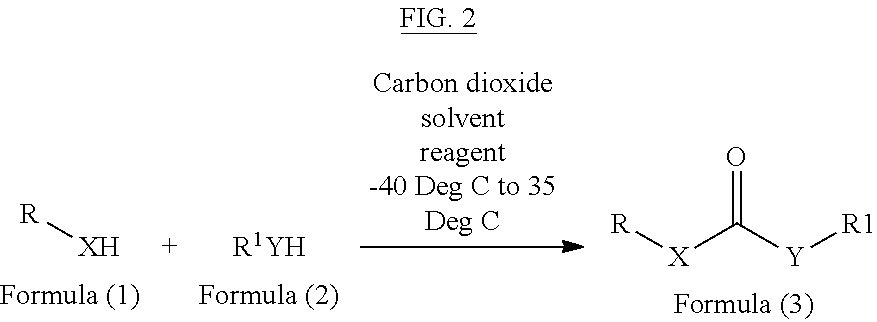Method of converting carbon dioxide into carbonyl compounds
- Summary
- Abstract
- Description
- Claims
- Application Information
AI Technical Summary
Benefits of technology
Problems solved by technology
Method used
Image
Examples
example 1
Synthesis of Dibenzyl Urea
[0066]In one method, carbon dioxide is purged in a solution of diisopropylethylamine (2 eq., 2 mmol) and p-toluene sulphonyl chloride (1 eq., 1 mmol) in dichloromethane for 30 minutes at room temperature. To this 1 eq. benzylamine is added dropwise at 0° C. with continuous purging of carbon dioxide. On completion of the reaction, reaction mixture is diluted with water and extracted in to 60 mL of ethyl acetate (60 mL), followed by first wash with 1N HCL (5 mL) and second wash with a mixture of NaHCO3 (10 mL) and brine (10 mL). Combined organic phases were dried over Na2SO4 and concentrated under reduced pressure to give dibenzyl urea which is further purified by column chromatography to obtain dibenzyl urea with 88% yield (366 mg)
[0067]The above procedure can also be performed by replacing POCl3 by other reagents and different bases as mentioned in following table 1.
TABLE 1EntryReagentBaseSolventYield (%)1POCl3Et3NDCM70%2MsClEt3NDCM50%3Ms2OEt3NDCM59%4p-TsCl...
example 2
Synthesis of 1-Benzyl-3-phenylurea
[0070]In one method, 2.2 eq, 4.4 mmol of di-isopropylethylamine is added to a mixture of benzyl amine (1 eq, 2 mmol) and aniline (2 eq, 4 mmol) in dichloromethane (10 mL) and carbon dioxide is purged through the reaction mixture for 30 minutes, followed by addition of 1.1 eq, 2.2 mmol of POCl3. On completion, the reaction mixture is diluted with dichloromethane and washed firstly with 1N HCl and secondly with brine. Combined organic phase is dried over Na2SO4 and concentrated to give 1-Benzyl-3-phenylurea, which was further purified by column chromatography to obtain 366 mg of 1-Benzyl-3-phenylurea (81% yield).
[0071]Methods disclosed in Example 2 are used to synthesize under mentioned carbonyl compounds with indicated percentage yields:
example 3
Synthesis of Benzyl benzylcarbamate
[0072]In one method, 2.2 eq, 4.4 mmol of di-isopropylethylamine is added to the mixture of benzyl amine (1 eq, 2 mmol) and benzyl alcohol (2 eq, 4 mmol) in dichloromethane (10 mL), followed by purging with carbon dioxide for 30 minutes and addition of 1.1 eq, 2.2 mmol of POCl3 thereafter. On completion, reaction mixture is diluted with dicholormethane and washed firstly with water and secondly with brine. Combined organic phase is dried over Na2SO4, concentrated and purified by column chromatography to obtain ? mg of Benzyl benzylcarbamate with 68% yields (330 mg).
PUM
| Property | Measurement | Unit |
|---|---|---|
| Temperature | aaaaa | aaaaa |
| Temperature | aaaaa | aaaaa |
| Angle | aaaaa | aaaaa |
Abstract
Description
Claims
Application Information
 Login to View More
Login to View More - R&D
- Intellectual Property
- Life Sciences
- Materials
- Tech Scout
- Unparalleled Data Quality
- Higher Quality Content
- 60% Fewer Hallucinations
Browse by: Latest US Patents, China's latest patents, Technical Efficacy Thesaurus, Application Domain, Technology Topic, Popular Technical Reports.
© 2025 PatSnap. All rights reserved.Legal|Privacy policy|Modern Slavery Act Transparency Statement|Sitemap|About US| Contact US: help@patsnap.com



